"One can find so many pains when the rain is falling."
- John Steinbeck
 |
| Winter's brushwork painted on a watery landscape |
The past three months have been unusually mild and wet; in that respect it's not been a lot different to the UK, where an array of plants have reportedly been flowering out of season. Here the mimosas bloomed early and shrubs like Coronilla have been in flower for several weeks.
 |
| Viburnum x bodnantense |
This was a welcome sight back in January when there was precious little to gladden our hearts in the rear garden, tortured as it is by north-easterly winds blowing across a flat expanse of marais.
This viburnum is a hardy fellow, easy to grow and maintain with very little pruning required. Its leaves aren't the most attractive as they tend to get wind-scorched, but if grown alongside other types of hedging it does fade into the background when rival shrubs get going in spring.
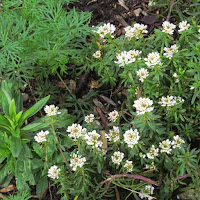 |
| Iberis sempervirens 'Snowflake' |
I like the fact that it's drought-tolerant and evergreen - sempervirens means 'always green' - providing quite a neat edge to beds and borders. Later in spring it should be completely covered in snowy blooms.
 |
| Back garden in February |
This has a practical purpose in that I'm tired of forever pulling up weeds which have seeded in the beds as a result of my grass strimming. It doesn't completely solve the problem as strimmed offcuts can fly quite high, but at least there's a bit of a barrier to halt the insidious weed-creep!
 |
| Linaria purpurea 'Canon Went' |
Another little plant which has survived winter in good shape is the cultivated toadflax, Linaria purpurea, which also came from Chiltern Seeds and whose grey-green foliage is not unlike a delicate euphorbia in the way it displays raindrops.
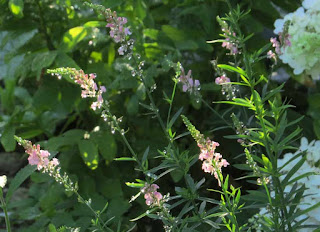 |
| Linaria purpurea 'Canon Went' |
The pale pink flowers appear in August, at the same time as the hydrangea blooms shown here. Happy in partial sun or shade, it's a useful filler and we also grow a purple-flowering variety which has seeded itself in a couple of shady spaces.
 |
| Crocus vernus 'Pickwick' |
For some real colour at this time of year one inevitably comes to rely on bulbs.
I make no excuse for featuring pictures of this Dutch hybrid every year because it's both early and robust, standing up to the rainy onslaught when some of its more delicate cousins just fall by the wayside. It also combines well with the silver-leaved dianthus, of which we have rather a lot these days ...
Nor can we ever get enough of hyacinths during those dark months when it seems too extravagant to keep buying cut flowers and yet you need a living reminder that spring will come eventually!
Sometimes, though, their scent is just too powerful in a small room and it's preferable to keep a few outdoors under shelter. This terracotta planter is sited beneath an overhanging shed roof and can be admired from our sitting room window -
that hyacinth perfume envelops me each time I fetch something from the tool shed.
Once their foliage has died down, we usually find a spot to plant out the bulbs so they can liven up another dreary season.
 |
| Heavily perfumed hyacinths - a passing lizard takes a sniff! |
Sometimes, though, their scent is just too powerful in a small room and it's preferable to keep a few outdoors under shelter. This terracotta planter is sited beneath an overhanging shed roof and can be admired from our sitting room window -
that hyacinth perfume envelops me each time I fetch something from the tool shed.
Once their foliage has died down, we usually find a spot to plant out the bulbs so they can liven up another dreary season.
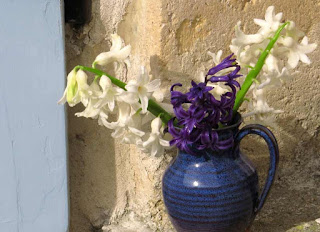 |
| Those waxy blooms make delicious cut flowers too |
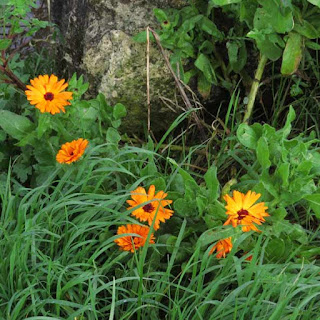 |
| Calendula officinalis growing in the verge |
However much we try to cultivate marigolds, they always seem to do better in the wild or where they have self-seeded in other people's gardens.
I'm talking about the Calendula varieties, known as 'pot marigolds', rather than the so-called French or African marigolds which are varieties of Tagetes.
They seem to prefer an open, sunny aspect - even in rough grass - and will happily flower throughout the winter.
 |
| Iris sibirica flowering in February |
Most types of iris will thrive in poor, almost non-existent soil, as long as their bulbs can be baked by the sun.
They do best when planted by themselves against a wall where their colour and shape can be shown off to full advantage.
Mixing them with other plants in a richer soil tends to encourage slugs and snails, particularly with the more fleshy types. There's nothing sadder than finding an iris flower which has been munched by molluscs!
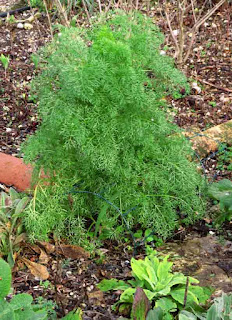 |
| Ammi visnaga |
Foxglove leaves are also full of holes caused by the tiny snails which abound in our garden. Thank heavens for hellebores whose tough foliage is pretty immune to such depredations, although they benefit from removal of their old leathery leaves which can detract from the beauty of their flowers and serve no useful purpose.
Similarly, it pays to tidy up our geum plants where last season's faded leaves spoil the look of their fresh new rosettes.
Freshest of all are the new plants coming from seed, such as Ammi visnaga - already quite tall and bushy - and a multitude of larkspur and nigella which have spread themselves all over the place, along with forget-me-nots. The latter are worth thinning out and transplanting to fill in a few gaps.
Although our local paths and meadows are still too muddy for walking, we hope those heavy downpours will soon dissipate to spring showers, enabling us to lose ourselves in the blossoming landscape. Gardens are calling - along with the birds - and we long to get back to work!
Similarly, it pays to tidy up our geum plants where last season's faded leaves spoil the look of their fresh new rosettes.
Freshest of all are the new plants coming from seed, such as Ammi visnaga - already quite tall and bushy - and a multitude of larkspur and nigella which have spread themselves all over the place, along with forget-me-nots. The latter are worth thinning out and transplanting to fill in a few gaps.
Although our local paths and meadows are still too muddy for walking, we hope those heavy downpours will soon dissipate to spring showers, enabling us to lose ourselves in the blossoming landscape. Gardens are calling - along with the birds - and we long to get back to work!
 |
| Mist through the reeds down our back lane |
 |
| Moisture lifting off fields in the early sun |

No comments:
Post a Comment